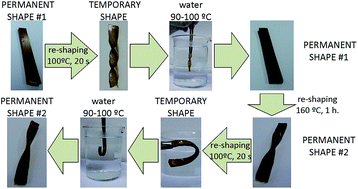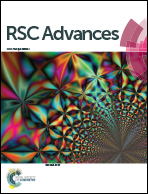Shape memory epoxy vitrimers based on DGEBA crosslinked with dicarboxylic acids and their blends with citric acid†
Abstract
Thermosetting polymers were synthesized from a commercial epoxy resin (diglycidyl ether of bisphenol A, DGEBA) and tricarboxylic (citric, CA) and different dicarboxylic (sebacic, SA and glutaric, GA) acids. Crosslinking of DGEBA–SA and DGEBA–GA systems was achieved using excess epoxy, which was homopolymerized after all the acid groups were consumed. It was found that the properties of the material depend on the diacid length and on the excess epoxy, and with the proper formulation, vitrimers with Tg values ranging from 51 °C to 62 °C, and a high rate of stress relaxation (less than 1 h at 160 °C to achieve 63% of relaxation) could be obtained. Notably, using a mixture of tri-functional CA with SA allowed a reduction in the epoxy excess while maintaining a high Tg value and faster stress relaxation. Three of the formulations were selected and their shape memory performance was studied. Good shape fixity and shape recovery ratios (>99%) were obtained, which indicate an overall good shape memory performance. These properties can be used to create different permanent and temporary shapes on a thermosetting polymer obtained from widely available and affordable raw materials.


 Please wait while we load your content...
Please wait while we load your content...